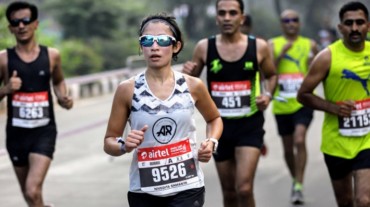
Remember the saying: No pain, no gain? These words rescued me during my second 42.2km race at the 2013 Mumbai Marathon. All was okay until the first 22 kilometres, when pain shot through my right leg. I stopped running. I just stood in one spot and teared up.
Then, a small voice inside me said, ‘No pain, no gain’. I started walking. Ten minutes later, the same voice urged me to jog. I tried to but couldn’t for long. So, I took turns walking and jogging. I only thought about meeting my family and friends at the finish line. Quitting was not an option. After 4 hours and 56 minutes, I finished!
From then to my personal best of 3 hours 36 minutes at the Berlin Marathon (42.2 km) in 2018, I have come a long way and I couldn’t be happier with taking up running for life!
This is why endurance running is so special. The feeling of accomplishment after all that hurt is unrivalled.

Frankly speaking, racing distances of 21.1 km or more is meant to be uncomfortable. It is the ultimate test of the harmony between your body and your brain. You must enjoy the pain, push through the struggle and emerge victorious.
And if you are preparing for a half marathon, here are some strategies to overcome pain during your next race:
1. Prepare two race plans
Plan A should be geared towards achieving your goal. Plan B should cater for any deviations due to unforeseen injury or weather-induced discomfort.
Start by studying the race course and its hydration and medical points. Also, plan your nutrition and hydration stops. Drink water every four kilometres and consume carbs or electrolytes every eight kilometres. It will bolster your mental and physical focus.
Remember the medical stops. Make your way there and stop, if the need arises.
2. Judge yourself on the pain scale
On a scale of zero to 10, self measure your pain. If it is above seven, stop immediately. If it is six or below, you can continue running by making some changes.
3. Stay positive and do not quit!
Keep laser focus on the finish: Don’t let the pain flood your thoughts. Shift your focus to that finish line and medal. Your brain will then shift your perception from pain to working harder towards completion.
Talk to yourself: Recall all the sacrifices you have made during your training. Think about the time away from your family, waking up before dawn and late at night to train, and missing out on social engagements. Make all of that count.
Play some mental games to distract yourself: Keep a track of the number of people you overtake. If that’s too boring, count the number of runners wearing bright yellow tees or shorts.
4. Make small physical adjustments to get to the finish
Change your breathing: If you experience sharp pain in your side or are breathless, slow down and take deep breaths. Sync your breathing with your steps.
Switch your stride: If you are cramping, are uncomfortable, or something hurts–lengthen or shorten your stride. Lift your knees more or kick your heels a bit.
Do a posture check: Relax your shoulders, straighten your spine, and swing your arms. Fatigue is normal and expected.
Walk or jog segments: Pick a landmark–a water stop, a lamp post, a tree. Decide to walk to it and then jog. Repeat, to the finish.
Fuel right: Your body stores are depleted. Take a few moments to get some glucose/electrolytes at a hydration stop.
5. Know when to stop
If you start experiencing any of the following symptoms, stop right there and seek medical attention:
6. Lastly, join a running community
Running a marathon requires a lot of mental strength and proper guidance from people who have the right knowledge about running. You find like-minded individuals who become like your extended family and push you to achieve your goals, and they do it together with you.
Also read: Run intended! Here are 6 exercises to help you prep for a marathon
Life is like a marathon where you have to take it slow, one step at a time. That’s how you progress, you just can’t sprint through it. Whether it is the upcoming IDBI New Delhi Marathon or something later on–being a part of a community helps you find inspiration every day.
Sport has the power to change lives. Even if you fail, it is never an end but only a step further to your progress.